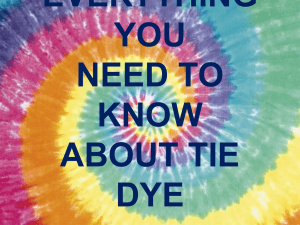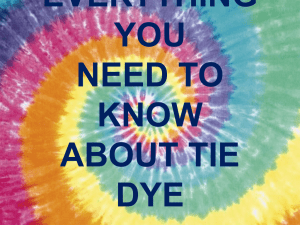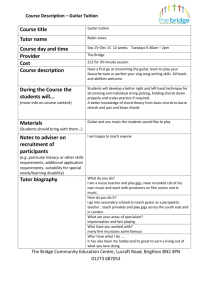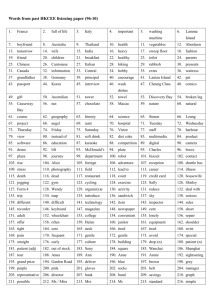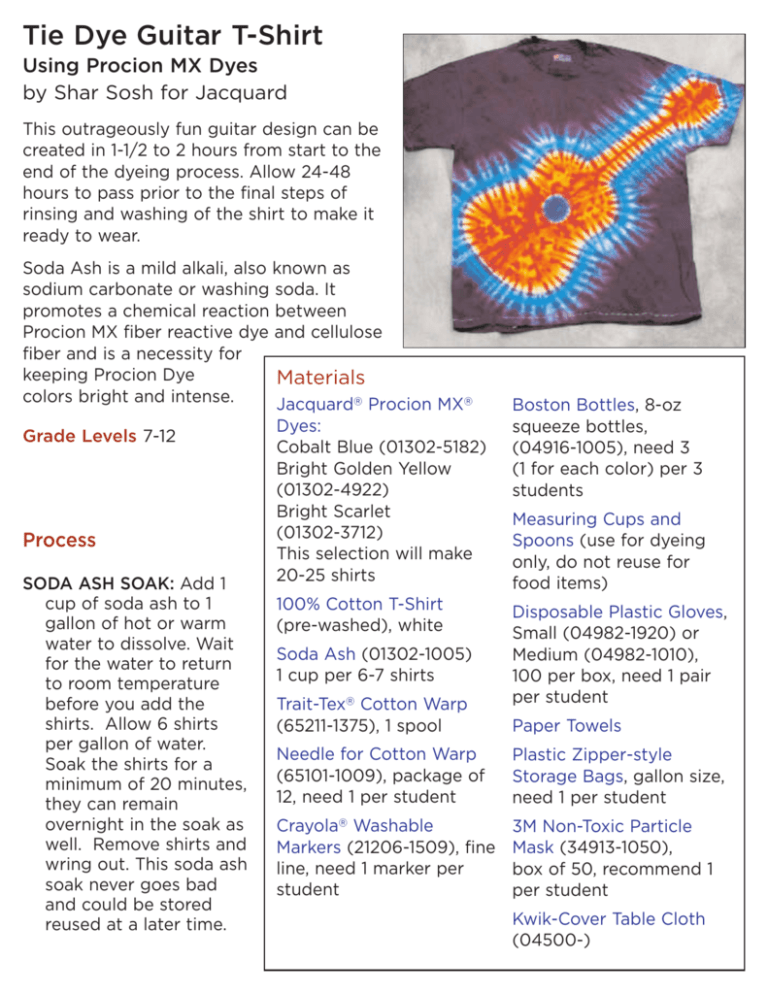
Tie Dye Guitar T-Shirt
Using Procion MX Dyes
by Shar Sosh for Jacquard
This outrageously fun guitar design can be
created in 1-1/2 to 2 hours from start to the
end of the dyeing process. Allow 24-48
hours to pass prior to the final steps of
rinsing and washing of the shirt to make it
ready to wear.
Soda Ash is a mild alkali, also known as
sodium carbonate or washing soda. It
promotes a chemical reaction between
Procion MX fiber reactive dye and cellulose
fiber and is a necessity for
keeping Procion Dye
Materials
colors bright and intense.
Jacquard® Procion MX®
Dyes:
Grade Levels 7-12
Cobalt Blue (01302-5182)
Bright Golden Yellow
(01302-4922)
Bright Scarlet
(01302-3712)
Process
This selection will make
20-25 shirts
SODA ASH SOAK: Add 1
cup of soda ash to 1
gallon of hot or warm
water to dissolve. Wait
for the water to return
to room temperature
before you add the
shirts. Allow 6 shirts
per gallon of water.
Soak the shirts for a
minimum of 20 minutes,
they can remain
overnight in the soak as
well. Remove shirts and
wring out. This soda ash
soak never goes bad
and could be stored
reused at a later time.
100% Cotton T-Shirt
(pre-washed), white
Soda Ash (01302-1005)
1 cup per 6-7 shirts
Trait-Tex® Cotton Warp
(65211-1375), 1 spool
Boston Bottles, 8-oz
squeeze bottles,
(04916-1005), need 3
(1 for each color) per 3
students
Measuring Cups and
Spoons (use for dyeing
only, do not reuse for
food items)
Disposable Plastic Gloves,
Small (04982-1920) or
Medium (04982-1010),
100 per box, need 1 pair
per student
Paper Towels
Needle for Cotton Warp
(65101-1009), package of
12, need 1 per student
Plastic Zipper-style
Storage Bags, gallon size,
need 1 per student
Crayola® Washable
Markers (21206-1509), fine
line, need 1 marker per
student
3M Non-Toxic Particle
Mask (34913-1050),
box of 50, recommend 1
per student
Kwik-Cover Table Cloth
(04500-)
Process, continued
fabric of the circle.
5. Pulling the Guitar: Hold both ends of
the kite string basted around the guitar.
TYING THE SHIRT:
Pull up on the fabric, scrunching it as
1. The Fold: Decide which shoulder you
you pull the strings. Continue the same
would like the guitar to start at and you
as you pulled for the circle. Be sure
will fold the front side of the shirt only
when you have pulled as much as you
from the shoulder to the waist in a
could that you are careful to follow the
diagonal fold.
lines of the guitar when wrapping/tying
This can be done by holding the shirt
the strings together. Make sure the fabat both the front of the shoulder and at
ric inside of the guitar is scrunched up
the waist. Shake the shirt to allow the
above the tied off string.
back side of the shirt to hang down
and out of the way. Make the diagonal
MIXING THE DYES: This step could be
centerfold of the shirt by laying it down
done ahead of time or while waiting for
on the table and smooth out the wrinthe shirts to soak in the soda ash.
kles around it. This fold will be the cenCAUTION: Wear a mask, rubber gloves
ter of the guitar.
and work in a well-ventilated draft free
2. The Design: Draw one side of the outarea. Do not have fans running.
line of the guitar using the washable
Powdered dye can cause a reaction if
marker. Draw also one half of the ceninhaled.
ter circle of the guitar. These will be the
Mix 1 cup of water with 2 teaspoons of
lines to follow with baste stitching dye. Double the dye amount for cobalt
temporary “in and out” stitches spaced
blue or any dark color. You can mix the
about 1/4" apart. Begin basting the
dye right in the squirt bottles. Add the
outer edge of the center circle. (You
powder dye first, add a little water,
will be basting through 2 layers of fabswirl and then gradually add the rest of
ric and have a half circle shape - do not
the 1 cup once the dye is dissolved. If
close off the circle at the fold). Leave
you have hard water, use distilled water
about 4" of cotton warp string at each
instead to produce brighter results.
end of the half circle and smooth out
HINT: Label colors with a permanent
the shirt again keeping the fold
marker, since it may be difficult to tell
straight.
them apart in the bottle.
Leave 4" of string at the base of the
guitar and baste stitch along the line
DYEING THE SHIRT: Begin applying dye
you drew. You will be basting through 2
with the lightest color first. Use paper
layers of fabric. Leave 4" of string at
towels to soak up any extra dye from
the top of the guitar as well.
the table so you don’t get color where
4. Pulling the Circle: Hold both ends of
you don’t want it on the shirt.
the kite string basted around the cen1. Generously apply the Bright Golden
ter circle (half circle) and pull up on the
Yellow to the guitar area, avoiding the
fabric scrunching the fabric together.
center circle. Be sure to push the
Pull as much string as you can back out
nozzle down into the guitar area to
of the fabric without loosing any stitchapply the dye.
es. Wrap the strings around the lines of
stitching and tie. Lift the scrunched-up 2. Generously apply Bright Scarlet along
the center fold (if it still remains) and
National Standards
Content Standard #1 — Understanding and applying media,
techniques, and processes
Process, continued
across the top fabric sticking up from
the guitar. The Bright Scarlet will blend
to create orange with the already dyed
Bright Golden Yellow areas. Avoid thecenter circle.
3. Apply Cobalt Blue to the center circle
and generously apply Cobalt Blue to
the rest of the entire shirt.
4. Place the dyed shirt with the guitar
design up in a Ziploc bag and let it sit
for 24-48 hours.
FINISHING:
1. After 24-48 hours remove the shirt
from the bag and rinse in cool water.
2. Carefully cut and remove the strings
and continue rinsing.
3. Increase the temperature of the water
and continue rinsing until the water is
almost clear.
4. Wash the shirt with liquid detergent in
a washing machine with a hot
wash/cold rinse setting. Place in dryer
or hang to dry.
Copyright © 2007 Dick Blick Art Materials. All rights reserved.
5-8 Students use different media, techniques, and
processes to communicate ideas, experiences,
and stories
9-12 Students conceive and create works of visual art that
demonstrate an understanding of how the communication of their ideas relates to the media, techniques, and
processes they use

